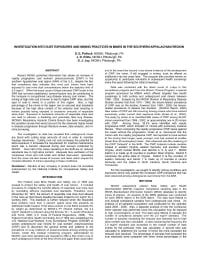Mining Publication: Investigation into Dust Exposures and Mining Practices in Mines in the Southern Appalachian Region
Original creation date: February 2009
Authors: DE Pollock, JD Potts, GJ Joy
NIOSHTIC2 Number: 20035147
2009 SME Annual Meeting and Exhibit, February 22-25, Denver, Colorado, preprint 09-009. Littleton, CO: Society for Mining, Metallurgy, and Exploration, Inc., 2009; :1-5
Recent NIOSH published information has shown an increase of rapidly progressive coal workers' pneumoconiosis (CWP) in the southern Appalachian coal region (SAR) of the U.S., despite the fact that compliance data indicates that most coal miners have been exposed to coal mine dust concentrations below the statutory limit of 2.0 mg/m3. While the exact cause of these elevated CWP levels in the SAR has not been established, several factors may be contributing to the increase in occupational lung disease among coal miners. The mining of high rank coal is known to lead to higher CWP rates, and this type of coal is mined in a portion of this region. Also, a high percentage of the mines in the region are on reduced dust standards because of the high silica content of the airborne dust resulting in miners possibly being exposed to excessive amounts of respirable silica dust. Exposure to excessive amounts of respirable silica dust can lead to silicosis, a disabling and potentially fatal lung disease. NIOSH's Respiratory Hazards Control Branch has been investigating the possible causes that would account for the observed higher trends in disease progression through literature review, data analysis, and in-mine surveying. The investigation to date has revealed that underground mines are faced with cutting large amounts of rock in order to maintain haulage clearances. Cutting rock not only increases the potential for silica exposure, it increases the requirement for machine maintenance which was a concern observed during dust surveys conducted by NIOSH. Over half of the mines operating in the SAR are on reduced standards due to high silica content. Adequate face ventilation of the continuous miner and roof bolter and limited down-wind operations from the miner are also issues of concern and items which require the constant attention of miners operating in these conditions.

NIOSHTIC2 Number: 20035147
2009 SME Annual Meeting and Exhibit, February 22-25, Denver, Colorado, preprint 09-009. Littleton, CO: Society for Mining, Metallurgy, and Exploration, Inc., 2009; :1-5
- Analysis of the Silica Percent in Airborne Respirable Mine Dust Samples from U.S. Operations
- Control of Respirable Dust
- Deposition Uniformity of Coal Dust on Filters and its Effect on the Accuracy of FTIR Analyses for Silica
- Equivalency of a Personal Dust Monitor to the Current United States Coal Mine Respirable Dust Sampler
- Evaluating Portable Infrared Spectrometers for Measuring the Silica Content of Coal Dust
- Laboratory Evaluation of a Canopy Air Curtain for Controlling Occupational Exposures of Roof Bolters
- Respirable Dust
- Respirable Dust Control for Surface Mines
- Silica...It's Not Just Dust
- Suggestion of a Cause-and-Effect Relationship Among Coal Rank, Airborne Dust, and Incidence of Workers' Pneumoconiosis
- Trend in Black Lung Cases Concerns NIOSH Researchers